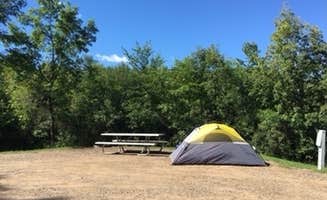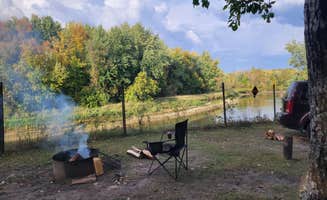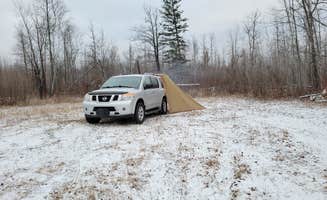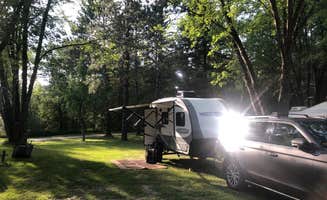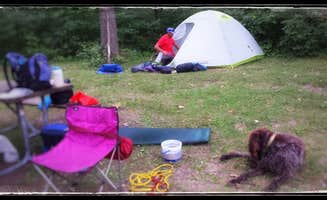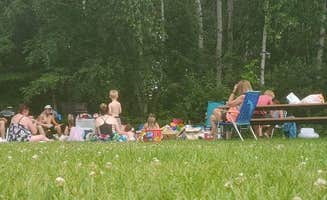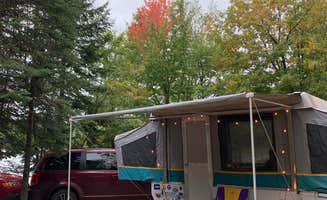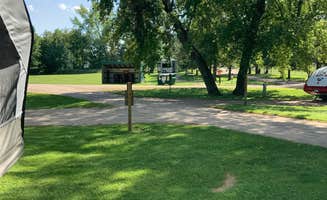Balsam area camping encompasses diverse ecosystems from dense pine forests to expansive wetlands within Minnesota's Aitkin County. Summer temperatures average 75-85°F with frequent afternoon thunderstorms, while spring camping often means dealing with persistent mud along trail edges. Campgrounds in this region typically sit at elevations between 1,250-1,350 feet, contributing to the area's noteworthy mosquito population during June and July.
What to do
Continental Divide hiking: Savanna Portage State Park features historically significant trails crossing the continental divide. "The hike to see the continental divide was really cool. We saw a fox and a deer which was cool. Then spent the evening canoeing one of the lakes listening to Loons," reports one camper at Savanna Portage State Park Campground.
Fishing from personal docks: Several Sandy Lake COE Recreation Area sites include private dock access for boats. "We were in spot 12 and it was right on the water. The spots are very small and no privacy between the sites but having a water view made up for it and you can park your boat on the dock in front of your spot," notes a visitor.
Golfing access: Minnesota National RV Park provides specialized camping for golfers with direct course access. "This is a relatively new campground built right next to the Minnesota National Golf Course clubhouse, and in the corner surrounded by Savannah holes 8 and 9. It's literally inside the golf course," explains one reviewer about this unique camping option.
What campers like
Clean facilities: Sandy Lake COE Recreation Area maintains well-kept amenities. "Great campground. Well maintained, great staff, good fishing. Multiple fishing areas, couple of playgrounds, and good history lessons," notes one visitor who appreciated the infrastructure.
Historical exhibits: The region features educational displays about fur trading history and local waterways. At Big Sandy Lake, visitors mention "historical exhibits about the dam and its history, and about the old furpost that used to be here."
Fall foliage viewing: The best season for reduced bugs and maximum color typically runs mid-September through early October. "I'm pretty sure this campground would be beautiful any time of year, but we visited on our anniversary in the fall and it was gorgeous! Most of the trees were yellow, and even in the overcast morning, gave the campground a wonderful warm glow," writes a visitor to Hay Lake Campground and Day-Use Area.
What you should know
Limited amenities at forest campgrounds: State forest camping sites near Balsam offer privacy but minimal facilities. "This is a state forest campground, and in MN, they are all very well maintained and the price is far better than a state park campground. In my opinion, they are far superior. Usually less crowded, lesser known, but better kept. Normally they are about $14, and sometimes free, depending on the time of year."
Bug pressure varies by season: Most campgrounds report significant mosquito activity from late May through August. "Savanna Portage State Park is a beautiful and peaceful spot for camping, especially if you enjoy tent camping. The campsites are well-spaced, private, and perfect for tents, offering a great connection to nature. One thing to note—there are a lot of bugs in the summer, so make sure to pack plenty of bug spray!"
Self-service registration: Floodwood Campground and several other smaller sites use honor system payment. "The check-in is completely self-check-in, with no apparent monitoring or security in the campground," notes one visitor, highlighting the need to arrive with exact payment.
Tips for camping with families
Playground access: Look for sites with dedicated children's play areas. "Following the winding pathway you will come to the campground. It's situated near four lakes and loads of biking/hiking. There is a lot to do in the area from fishing, hiking, biking, and nature watching. Loon lake has a nice little 'park' with a beach so that is great for families."
Wildlife viewing opportunities: Many camping sites near Balsam, Minnesota offer chances to spot animals safely. "We saw a fox and a deer which was cool. Then spent the evening canoeing one of the lakes listening to Loons."
Screen tents essential: Jay Cooke State Park Campground and other sites recommend bug protection for mealtimes. "We enjoyed renting canoes for a bit in the afternoon and borrowed a kids activity kit. The bugs were pretty intense, a lot of mosquitoes, flies, and several wood ticks, so we recommend a screen tent for eating."
Tips from RVers
Site size considerations: Many campgrounds have limited turning radius for larger rigs. "We had no issues backing our 40' Brinkley TH into the site and still had room to put our patio down and park our F-450. The only problem with site 25 is that the entrance to site 24 comes in at a weird angle right next to the entrance of site 25."
Utilities placement: At Minnesota National RV Park, hookups require longer connections than standard. "The utilities are in the far back of the site. I needed about 20' of sewer, electric, and water hose to reach my rig."
Water pressure management: Several campgrounds provide higher-than-average water pressure. "The water pressure is very good at 60+ psi, so suggest a reducer."



